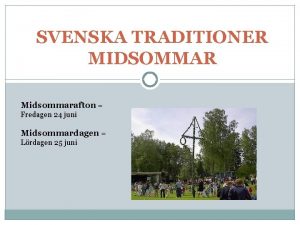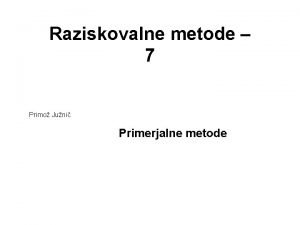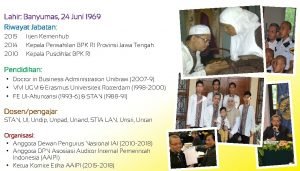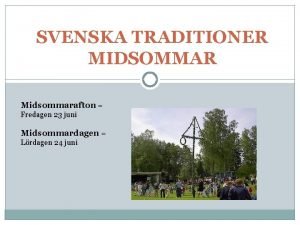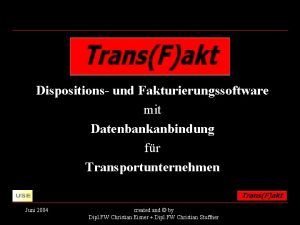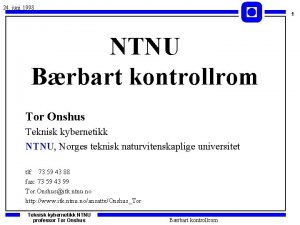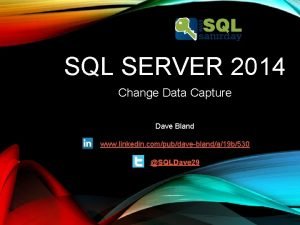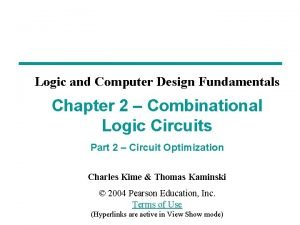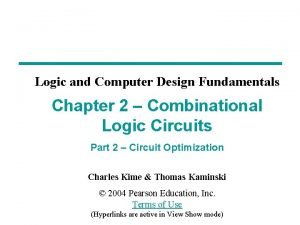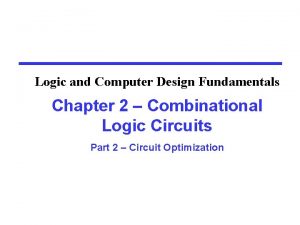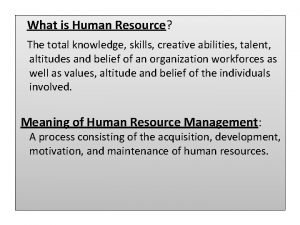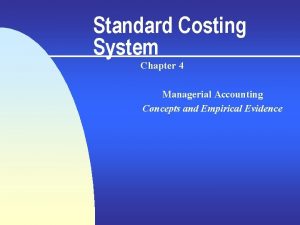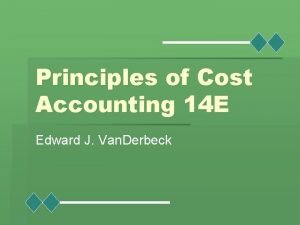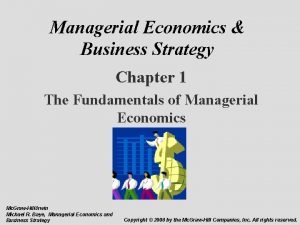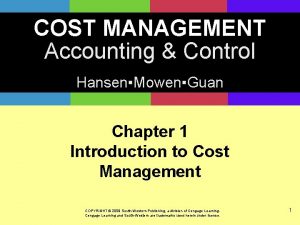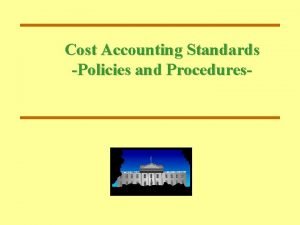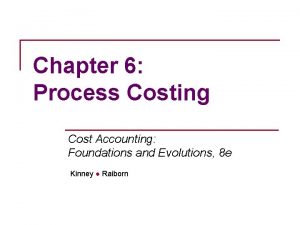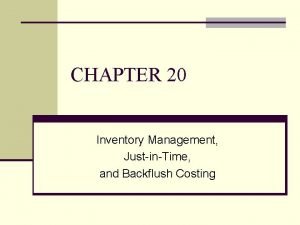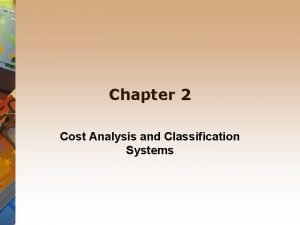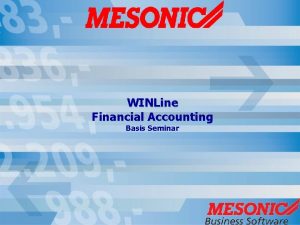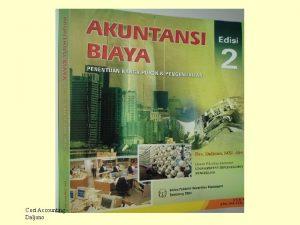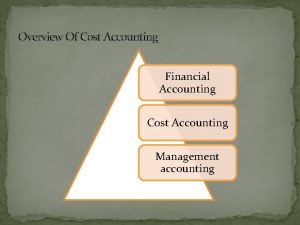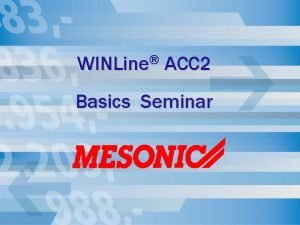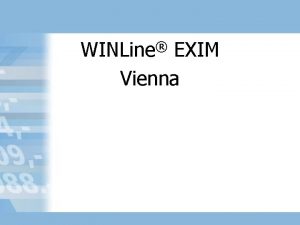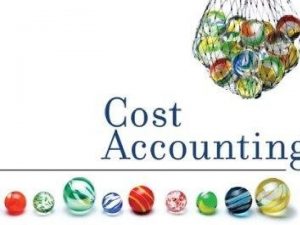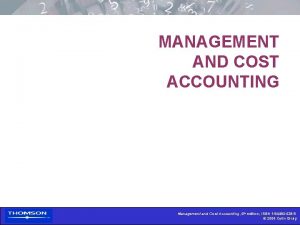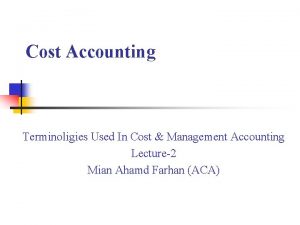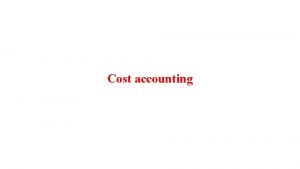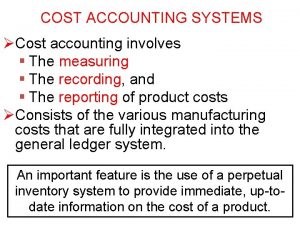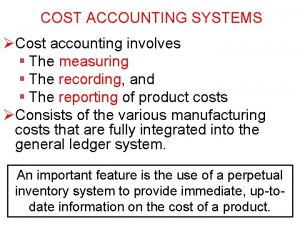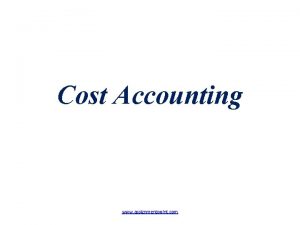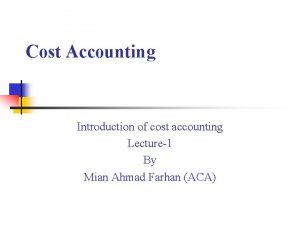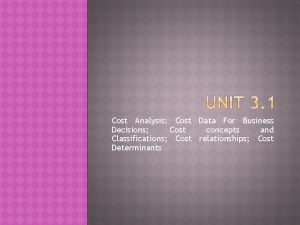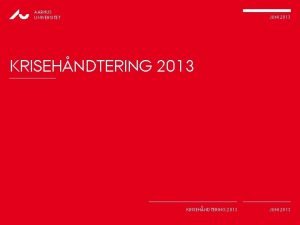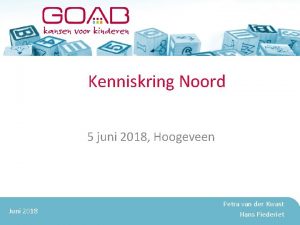WINLine Cost Accounting Juni 2005 COST Accounting Data















































- Slides: 47

® WINLine Cost Accounting Juni 2005

COST Accounting – Data From: Ø Ø Ø ACC 1 ACC 2 ASSET PAYROLL PROD Juni 2005

Concepts Ø Entry of costs • Mostly in ACC 1 Ø Cost Distribution • Distribution of costs/revenues to organizational units (cost centers) Ø Cost Allocation • Allocation of costs to operational projects (cost objectives) Juni 2005

COST Procedures Ø Full cost accounting • All costs are distributed to the cost centers and cost objectives Ø Partial cost accounting • Only costs directly caused by a cost objective are distributed to the cost objective Juni 2005

Time Aspect Ø Actual cost accounting • Comparison of the actually incurred costs in a past period of time Ø Planned cost accounting • Future costs will be planned Ø Target cost accounting • Analysis of ACTUAL units based on budget calculation rates Juni 2005

Cost Type Organization Ø According to contributing source • • Material costs Worker costs Energy costs etc. . Juni 2005

Cost Type Organization Ø According to use: • Variable costs • Fixed costs • Variable overhead costs Juni 2005

Cost Type Organization Ø According to Type of Entry • Direct Costs • Direct costs, e. g. , piece wages, raw material direct costs, etc. • Indirect costs • These costs cannot be attributed directly to a cost objective (e. g. , administrative and marketing costs) Juni 2005

Variator Ø The variator defines the proportion of cost that is variable • 0 = 100 % fixed costs • 10 = 100 % variable costs • 7 = 70 % variable costs Juni 2005

Index Ø Permits the conversion of expenses into costs (during posting) Ø Example: • Acquisition value = 10, 000 • Replacement value = 15, 000 • Index = RV/ AV * 100 = 150 Juni 2005

Cost Centers Ø Organizational units within a business Ø Divisions: • Main cost centers Production • Administration/Marketing • • Indirect Cost Centers • Holding units that are entirely allocated Juni 2005

Calculated Costs Ø Cost types can be calculated per cost center based on previously defined basic cost types (e. g. , payroll secondary costs based on incurred piece wages) Juni 2005

Cost Objectives Ø Distribution of direct costs Ø Pre-calculation based on past values (Budget. Overhead burden rates) Ø Post-calculation based on the overhead burden rate calculated in the Expense Allocation Sheet Ø Period (duration) Juni 2005

Allocation Ø There are five tab areas in the menu item: • METHOD (one-time setup) • PLAN (one-time setup) • ALLOCATION (automated allocation suggestions based on current allocation percentages) • 13. Period – for monthly aliquote calculations (e. g. , from asset management) • VOID (Cancel allocation without recalculation) Juni 2005

Cost Allocation Ø Automatic suggestion of all existing allocation plans. • The system date is suggested as posting date. Manual change is possible. • Posting period from the Company Base Info is suggested. More than one period can be selected. • Allocation can be executed as often as desired. Any previous allocations are deleted and a new total allocation period is calculated. Juni 2005

Allocation - Method Ø One-time definition of allocation method • Recieving cost centers: Definition of cost centers to which entered costs that have temporarily been held in “Indirect Cost Centers“ will be allocated. • Entry of cost type that should be employed as calculation basis. • Calculation basis formed based on posting amount or unit is possible. Juni 2005

Calculation Basis-Verh. zahlen Ø Calculation basis is formed based on the percentage porportion of receiving cost centers. • Based on posted costs • Based on posted revenues • Based on posted units (hours, kg, m²) Ø The calculated proportion factors can be queried with the PROPORTION FACTORS button. Juni 2005

Allocation - Plan Ø One-time setup of the cost centers that should be allocated. • Allocation method: Selection of an existing method (source cost center and destination cost center for allocation). • Indirect cost centers: Entry of indirect cost center to be allocated. • Cost types: To allocate individual portions of a cost center, it is possible to restrict to particular cost type areas here. • Allocation cost type: To easily identify allocation lines, it makes sense to assign an individual allocation cost type. Juni 2005

13. Period Ø Postings from Period 13 (e. g. , depreciation from ASSET) • These postings are automatically allocated spread over all fiscal year periods on an aliquote basis. Juni 2005

Allocation – Void Ø All executed allocations period are shown in the Void tab area. • During cancellation, allocation lines of the selected period are deleted. • And the new allocation is not automatically calculated (this would normally occur when allocation is executed again for the period). Juni 2005

Planned Costs Accounting ØSetup of a planned cost type with units and a provisory costing rate per unit (e. g. , hourly rate) ØBudgeting of cost centers/cost objectives by unit planned costs (planned units, planned rates) ØEntry of ACTUAL units (hourly billing, etc. ) Target costs (ACTUAL units to planned rates) ØAllocation based on performed units results in a ACTUAL rate ACTUAL costs (ACTUAL units at ACTUAL rates). Juni 2005

WINLine® ASSET Basis Seminar Juni 2005

Scope of Functions Ø Depreciation • annual • periodic Ø Asset Overview/Depreciation Preview Ø Asset Base Info Ø Acquisitions/Disposals Ø Unit values Ø Investment allowance list Ø Valuation Reserves Juni 2005

ACC 1 Interface Ø Automat. adoption of tax-based depreciation to ACC 1 Ø Adoption of period depreciation to ACC 1 Juni 2005

COST interfaces Ø Automat. Adoption of implicit depreciation to COST (based on repurchase value, or implicit useful life, allocated to periods) Ø OR: As as alternative, an adoption to COST with the book values from ACC 1 can be executed. Juni 2005

Asset Parameter Ø Ø Ø Ø Default posting account for depreciation Default depreciation rules Lower limit unit value % Useful life in months Reminder value option IA update for selected asset groups Info on last implicit or tax-based depreciation run Post costs with ACC 1 Juni 2005

Asset Categories Ø Ø Ø Ø Ø Default for stock merchandise: ACC 1 account Vendor Inventory description Useful life Asset type (LV asset, etc. ) Default deprec. rules IA, accel. deprec Write-off type Juni 2005

Data Entry Ø Acquisitions • A new asset is posted either as separate inventory object or as a sub-asset to an existing asset. Juni 2005

Data Entry Ø Partial value disposal • A portion of asset value is lost (damage, sale, value depreciation, . . . ) • Automatic calculation of disposal value (BV and depreciation) • Recalculation of remaining book value and new annual depreciation Juni 2005

Data Entry Ø Transfer • An asset value is transferred to another asset (e. g. , activation of building under construction to a Building) • Automatic recalculation of book value and annual depreciation Juni 2005

Data Entry Ø Disposal • An asset is completely disposed of (i. e. , is automatically posted off the books) • Automatic calculation of disposal depreciation and disposal value based on BV and asset value Juni 2005

Data Entry Ø One-time (extraordinary) write-ups/write-offs Ø Asset Modification • Correction of existing Base Info in case of commercial obsolescence, damage, regulatory change, or unforeseeable losses in value, etc. Juni 2005

Data Entry Ø Performing tax-based depreciation • periodic (monthly, quarterly, etc. ) • At year’s end, whereby all values for periodic depreciation are automatically corrected and reposted based on the current asset conditions. Juni 2005

Theoretical Considerations Ø Depreciation • Distribution of acquisition or production costs over the useful life • For acquisitions after 1. 1989, you can no longer apply accelerated depreciation Juni 2005

Theoretical Considerations Ø Valuation guidelines • Relaxed lower of cost or market principle Depreciable fixed assets (machines, office equipment, . . . ) • Non-depreciable assets (land, patents, investment paper) • Juni 2005

Theoretical Considerations Ø Accelerated Depreciation • Only applicable in exceptional cases since 1. 1. 89 (additional write-off of 40 % of asset value in year of acquisition) Juni 2005

Theoretical Considerations Ø Straight-line depreciation • Acquisition value/production costs are equally distributed over the useful life Ø Declining balance depreciation • Percentage of depreciation is not calculated from AV, but rather from residual book value Ø Graduated depreciation • Percentage that can be assigned over a period of several years. Depreciation is based on the acquisition value. Juni 2005

Theoretical Considerations Ø With a common asset management system – independent of country – all depreciation rules can be used. Ø The date of acquisition forms the basis • 0 – exact monthly deprec. calculation • 1 – semi-annual depreciation (A) Check whether acquisition was in first or second half of year and either six or twelve months depreciation, respectively. • 2 – annual depreciation Independent of acquisition, the entire annual depreciation is applicable. Juni 2005

Theoretical Considerations Ø Declining balance depreciation – with automatic switch to straight-line depreciation Ø Graduated depreciation – for fixed business assets (buildings) – separate depreciation graduations Ø Special depreciation – in first two years up to 20 % of acquisition value can be applied in addition to annual depreciation. Ø “Pro ratio temporis“ rule / simplifications rule Juni 2005

Theoretical Considerations Ø Consumption depreciation • Depreciation amounts are based on consumption rate values of asset (e. g. , gravel pit) Ø Extraordinary depreciation • Extraordinary depreciation, i. e. , the asset value may be decreased by a partial value (see lower of cost or market principle) Juni 2005

Theoretical Considerations Ø Date • Acquisition date • Relevant for posting of investment allowance • Date of start-up • Relevant for depreciation calculation (semiannual rule) Juni 2005

Theoretical Considerations Ø Low-value Assets • Depreciable assets whose AV or production costs do not exceed ATS 5, 000 (excl. VAT) • Can be written off 100% in year of acquisition • The unit value is decreased for five running years by 20 % respectively Juni 2005

Theoretical Considerations Ø Investment Allowance • An investment allowance of X % (depending on type of asset and date) can be applied to reduce profits. • The asset must have a minimum useful life of four years and be used domestically. • The IA can only be applied to acquisition costs or production costs that occur before December 31, 2000. Juni 2005

Theoretical Considerations Ø Investment allowance • After a period of four years the IA is posted tax-free to the capital account (or taxable reserves account) • If the asset is disposed of within four years, a penalty of 5% annually is payable on the IA Juni 2005

Theoretical Considerations Ø Investment Reserves • Dissolving the IR occurs by acquisition of assets with the amount that can be applied as IR. • If the IR is not fully consumed within four years, the remaining portion is to be dissolved as increase in profit with a penalty of 5% annually. Juni 2005

Theoretical Considerations Ø Valuation reserves • For this reason, hidden asset reserves that have belonged to corporate assets for a minimum of seven years can be transferred to a “same type” asset within three years (decreasing acquisition value and therefore also annual depreciation) • If not transferred within three years, dissolution is performed with a penalty of 5% annually to increase profit. Juni 2005

Theoretical Considerations Ø Dissolution of Valuation Reserves • Reserves of accel. depreciation • After write-off of acquisition value, this can be annually dissolved to increase profit • Hidden reserves • This can be dissolved in same proportion of annual depreciation to acquisition value. Juni 2005
 Svenska traditioner midsommar
Svenska traditioner midsommar Primo juni
Primo juni Dreißig tage hat september
Dreißig tage hat september Wetter paris märz
Wetter paris märz 27 juni 2008
27 juni 2008 Bescheidungsurteil vornahmeurteil
Bescheidungsurteil vornahmeurteil 24 juni 1969
24 juni 1969 Midsommar 23 juni
Midsommar 23 juni Rini juni astuti
Rini juni astuti Juni
Juni 24 juni 1998
24 juni 1998 Cdc sql server 2014
Cdc sql server 2014 Cost accumulation and cost assignment
Cost accumulation and cost assignment Cost accumulation and cost assignment
Cost accumulation and cost assignment Manufacturing cost vs non manufacturing cost
Manufacturing cost vs non manufacturing cost Job costing definition
Job costing definition Floatation cost
Floatation cost Manufacturing cost vs non manufacturing cost
Manufacturing cost vs non manufacturing cost Cost accumulation and cost assignment
Cost accumulation and cost assignment Manufacturing cost vs non manufacturing cost
Manufacturing cost vs non manufacturing cost Difference between standard costing and variance analysis
Difference between standard costing and variance analysis Cost of equity
Cost of equity What is a period cost on the income statement
What is a period cost on the income statement Dennis geyer
Dennis geyer Standard costing
Standard costing Literal cost gate input cost
Literal cost gate input cost Distinguish between average cost and marginal cost
Distinguish between average cost and marginal cost Cost control and cost reduction difference
Cost control and cost reduction difference Job order costing vs process costing
Job order costing vs process costing Ordering cost and carrying cost
Ordering cost and carrying cost Literal cost gate input cost
Literal cost gate input cost Literal cost gate input cost
Literal cost gate input cost Opportunity cost vs trade off
Opportunity cost vs trade off Cost control and cost reduction project report
Cost control and cost reduction project report Cost control and cost reduction project report
Cost control and cost reduction project report Cost behavior patterns
Cost behavior patterns Jaggi and lau model
Jaggi and lau model Standard costing system
Standard costing system Prime cost accounting
Prime cost accounting Oklahoma cost accounting system
Oklahoma cost accounting system Opportunity cost in accounting
Opportunity cost in accounting Nature of managerial accounting
Nature of managerial accounting Cost concept definition
Cost concept definition Cost management accounting and control
Cost management accounting and control Cost accounting standards
Cost accounting standards Eup accounting
Eup accounting Backflush costing
Backflush costing Example of semi variable cost
Example of semi variable cost
